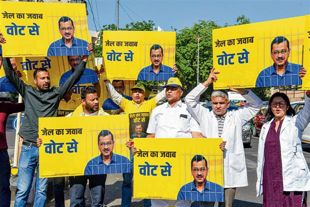
A still from Jawani Phir Nahi Aani
Gautam Kaul
When commercial films take over our lives, it is time to take a look at the lay utterances of literary critics that cinema only entertains and does not influence our conduct or thinking. The incident at Nahargarh outside Jaipur when a man was found dead and hanging from the ramparts of the old fort has added a new twist to the current agitation to stop film Padmawati from being released. Committing suicide for a commercial film was never part of entertainment of any national cinema, but in India, we seem to have done the unthinkable. Yes, film fans have burnt city buses, committed arson to theatres, gone on hunger strikes, stopped trains, and done many other stupid acts, but an alleged suicide?
We do take our cinema seriously.
And lately across the border, similar happenings are being reported if not to the extreme acts which we seem to specialise. It simply points to the fact that on the subcontinent, all hearts beat together.
Our cousins in Pakistan, too, are doing things which we can applaud distantly in agreement; in this case, it is cinema, which is the chosen vehicle to set the masses to think of their society, and not the utterances of leaders, or in print. The winds of change in cinema of Pakistan are markedly different but equally impressive. Sad to say, the very mode of film trade between the two countries is cast in such a mould, as to prevent a free flow of ideas. We are more aware of the kind and quantity of armaments in the holding of Pakistani defence forces, than how the people eek out a living in an area which is threatened with economic disaster and deprivations of all sorts. And we have certainly not given a thought to what is the cinema created for the people.
Thankfully our cinema is not denied to them as nearly all our films made in Hindi, Urdu and Punjabi are being freely imported through official channels and screened in the 400-odd movie screens in that country. Only four films, Khuda Ke Liye, Bin Roye, Ramchand Pakistani and Bol have found any patrons on our side. Their latest good film fielded for the category of foreign film Saawan was invited, and then, not screened at IFFI in Goa, for being a Pakistani product. In our own way, we have stated that the world is one family, except the guy who lives as our neighbour!
Even when about 40 films in five languages are being made in Pakistan annually, they still do not provide enough software to keep the local film exhibition trade running successfully. The theatres require more films to be offered to them to run the establishments for four shows a day seven days a week. Old Indian and local films, those imported from Iran, Egypt, Turkey and the USA in the past kept the theatres running but did not draw the kind of frenzied crowds to make repeat visits. Only the films made in Mumbai created the dreams which film exhibitors dreamt of. Local films occasionally also brought crowds to the theatres like film Aina (1979), which ran for five years in one theatre in Lahore, but that was not enough to sustain a trade.
We normally associate films from across the border as third class entertainment fare. However, Pakistani film industry also makes a small per cent of good films, and there is also a rising New Wave Cinema.
On our side, recent films such as Pink, Udta Punjab, Punjab 1984, Neerja, Dangal, Chauthi Koot, Aligarh, Talwar, Toilet: Ek Prem Katha, Masaan, Sairat, Tithi, Bajrangi Bhaijaan, Baahubali 1&2 et al have created a niche for themselves. Across the border, films like Ramchand Pakistani, Zinda Bhaag, Dukhtar, Bol, Bin Roye have created an equal effect.
There has also been a competition to have a tit for tat activity in cinema. When Mumbai produced Special 26, and later Baby, there was an instant reply with Waar, a local blockbuster, which was a good example of jingoism. This film suggested that RAW had a hand in the terrorist raid on the local Police Academy. When M. S. Dhoni: The Untold Story was made, it was responded with I Want To be Shahid Afridi, an equally well-made film.
But lately we can offer our shoulder to the Pakistani film industry for some worthwhile efforts which indicate that some young filmmakers are not afraid to pick on subjects, which should make the audiences think twice of their political environment. Two films require special mention, which have seized the theme of local terrorism head on. These are: Na Maloom Afraad and Jawani Phir Nahi Aani. The former has its story in the tumultuous days of urban terrorism in Karachi while the latter tackles the problem of futility of terrorism in north Pakistan.
Like we are facing the rather unique scenario of mass preoccupation with Padmawati, our friends in Pakistan are equally in discussion with the latest film Verna, directed by Shoaib Mansoor, who also made Bol. Verna is, perhaps, the most important cinematic document to emerge in Pakistan as it examines the various aspect of female rape. The film has issues of public concern, which have raised the hackles of fundamentalists and extreme conservative social order. Naturally, there are ongoing demonstrations against the film’s release and some extreme persons are seeking the head of the filmmaker. Such stirring against films were, till now, reserved for films under consideration for import from India, but now as the winds of change are also blowing in our neighborhood, the outcry against Verna is welcome. After all, did we not discuss the aftermath of screening of film Pink.



























